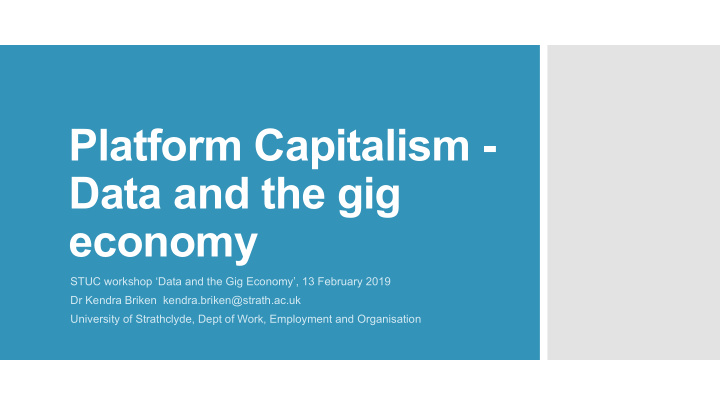



Platform Capitalism - Data and the gig economy STUC workshop ‘Data and the Gig Economy’, 13 February 2019 Dr Kendra Briken kendra.briken@strath.ac.uk University of Strathclyde, Dept of Work, Employment and Organisation
https://www.rosalux.eu/publications/the-long-struggle-of-the-amazon-employees/ Prologue There is power and resistance Over the years there has been an increase in collective action against working conditions at Amazon.
Platforms can be understood as economic actors within a capitalist mode of production* business models: capitalising on big data and the development of their monopolising platforms. data is a resource ‘to be extracted, refined, and used in a variety of ways’ advertising platforms (e.g. Google, Facebook): extract user data I. and capitalise on ad space; The Rise of cloud platforms (e.g. Salesforce): own & rent out hardware and software; Platform industrial platforms (e.g. GE, Siemens), which build the necessary capitalism infrastructures ‘to transform traditional manufacturing into internet- connected processes’ (49); product platforms (e.g. Rolls Royce, Spotify), which make use of other platforms ‘to transform a traditional good into service’ (49); and lean platforms (e.g. Uber, Airbnb): operate on a business model of minimal asset ownership. *See: Nick Srnicek (2016) Platform Capitalism (Theory Redux). Polity Press. 120 pages.
Cloud computing: enabler for business models Data collection, generation, extraction, but the crucial point is II. data storage and recording of real time events How did we i.e.: 15 million Uber trips are get here? completed each day, in 65 countries, over 600 cities, all on one platform Space Irony: Uber uses Amazon Web is the limit Services Cloud-space allows for auto- scaling and flexible usage, in both directions: For peak and low times! (no payment for no use!)
Platforms Offer intermediary digital infrastructures Using network effect But also: Rely on cross-subsidisation: the most obvious business Platform might not be the one that is the most profitable business Active in constant user engagement: ‘nudging’ and pushing into ‘closed circuits’ organised like gated models communities In regards to work and employment: Technology driven: The good jobs for the high skilled, the bad jobs made invisible: ‘Artificial artificial intelligence’ (Bezos 2007, New York Times)
The weight of the material world is burdened by the workers alone. They are ‘employees’ still in fulfillment Amazons centres, but micromanaged like gig Christmas workers. advert – and The work and hardship of The truth References: On delivery drivers: Newsome, Moore, Cillas (2016) Parcel • Delivery drivers behind the delivery workers and the degradation of work • Amazon workers in fulfilment https://www.opendemocracy.net/beyondslavery/newsome- moore-ross/parcel-delivery-workers-and-degradation-of-work centres click… • Microtaskers On Microtaskers, Irani (2015) Justice for Data Janitors, https://www.publicbooks.org/justice-for-data-janitors/ is made invisible. On Amazon fulfilment see Briken, K., & Taylor, P. (2018). Fulfilling the 'British Way': beyond constrained choice - Amazon workers' lived experiences of workfare. Industrial Relations Journal .
‘Hard HR management’ with a twist Data driven strategies Amazon picks from the handbook of lean management Handhelds, wristbands GEMBA walks in the morning Data: Data derives directly from HQ in Seattle. Constant benchmarking of all centres in real time. Discipline Workforce management allows to calculate the demand on up to 15min slots and Despotic tactics Hands-on direct control and supervision delegate? Not meeting the targets: Having a ‘word’, or receiving ‘a visit’, would invariably mean injunctions to work faster. Testimonies and evidence we gathered in our ongoing research. See also paper presented at the International Labour Process Conference in Berlin 2016): Briken, K., P. Taylor and K. Newsome (2016) 'Work Organisation, Management Control and Working Time in Retail Centre’, paper presented at ILPC Berlin 2016, 2-4 April. The paper is available on request (kendra.briken@strath.ac.uk)
Workers at Amazon (and elsewhere) are integrated in a data and technology driven system fulfilling the dream of ‘scientific management’: total division of execution and operation At the same time they are trapped in a double dehumanizing closed circuit: Amazons Datafare system: reducing workers to being a robot Data and ( robota means literally "corvée", "serf labor", and figuratively "drudgery" or "hard work" in Czech) data: The governments Workfare system: reducing them to numbers (see Briken/Taylor 2018: Fulfilling the 'British Way' : beyond constrained choice - Amazon workers' lived experiences of workfare. Industrial Relations Journal) Workers perspectives Amazon and other companies receive subsidies to ‘create’ jobs areas with high unemployment rates; they are taxed less; But: They also don’t need to care for the seamless flow of labour supply either. ‘I would have rather worked at McDonald’s but there was no bus’ ‘I knew they would sack me but job center would send me back anyway’
Platforms are resilient and collective action needs a long breath Good news: The struggle against bad Fighting platform employers in the gig economy only platforms – has begun – but it has! fighting There is a need to push also against: Workfare system to get people out of misery windmills? first Plus: Educate the tech world, educate students & school pupils about their rights!
Recommend
More recommend